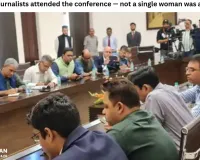The Perfect Storm: How Climate and Economic Crises Are Pushing India's Farmers to the Brink
Digital Desk

In the wake of unprecedented environmental disasters and economic pressures, India's agricultural sector—the backbone of the nation's economy and food security—is facing a catastrophic convergence of challenges that demand urgent policy attention and systemic reform.
The Submerged Heartland: Punjab's Agricultural Devastation
The northern state of Punjab, traditionally known as India's breadbasket, is reeling under what farmers describe as the worst flooding in four decades . The catastrophe comes at the most devastating time—just weeks before harvest—submerging thousands of hectares of valuable Basmati rice crops under water and sediment .
The human cost is staggering. Farmers like Gurvinder Singh from Gurdaspur face complete ruin after taking substantial loans for daughter's weddings and crop investments. "I cannot afford this shocking flood at this time in my life. We are ruined," Singh told Al Jazeera, capturing the despair of countless farming families . With over 450,000 acres of farmland affected according to initial estimates—and independent economists suggesting the final impact could be five times higher—the scale of destruction threatens to cripple Punjab's agricultural economy for years to come .
A Hollow Response: The Shortcomings of Government Relief
While state governments have announced relief packages, the ground reality reveals a troubling disconnect between policy announcements and practical implementation. In Punjab, the state government has offered approximately ₹20,000 ($230) per farmer for crop loss—a sum that agricultural experts call "too little to deal with the monumental challenges that lie ahead" .
The pattern of inadequate response repeats in Maharashtra, where farmers have slammed a ₹31,628 crore relief package as a "sham" . The compensation comes with such stringent eligibility criteria and bureaucratic hurdles that many affected farmers cannot access the funds. As farmer leader Raju Shetti pointed out, the government has imposed a 3-hectare cap on land holdings eligible for compensation, automatically excluding many affected farmers .
More troubling is what agricultural policy expert Vijay Jawandhia calls "shuffling funds"—repackaging existing budgetary allocations as new relief measures. "This expenditure was budgeted for and was to be spent anyway. How can it be included in the package?" he questioned .
Beyond Punjab: A Triple Crisis Across India's Farmlands
The agricultural distress extends far beyond Punjab, creating what can only be described as a triple crisis across India's farmlands :
· In Maharashtra, nearly 14.44 lakh hectares across 29 districts were submerged during August rains, affecting diverse crops from soybean and cotton to turmeric and sugarcane .
· Madhya Pradesh, India's leading soybean-producing state, is battling a severe outbreak of Yellow Mosaic Virus that threatens oilseed production targets .
· The simultaneous timing of these disasters across multiple states stretches government resources and compounds their impact on national food security.
The timing creates a nightmarish scenario for farmers racing against time to clear fields of sediment and prepare for the crucial Rabi (winter) season wheat planting, which must begin by early November to avoid yield losses .
The Structural Crisis: Unemployment and Economic Pressures
Compounding the immediate agricultural disaster is India's broader employment crisis, which threatens to exacerbate rural distress. Official unemployment figures, which rose to 5.6% in June 2025, mask the true severity of the situation . Independent data reveals that 44.5% of Indians aged 20-24 are unemployed despite holding degrees, and youth unemployment stands at a troubling 17.6% .
This employment crisis is particularly alarming because it represents what Morgan Stanley economists term a "jobs trap"—with millions of young Indians excluded from productive work and underemployment widespread . The situation is worsened by external economic pressures, including Trump's 50% tariffs on Indian goods, which particularly impact labor-intensive export sectors .
Perhaps most concerning is the reverse migration trend observed by economists Santosh Mehrotra and Jajati Parida. After falling for half a century, agriculture's share of total employment has risen from 42% in 2018-19 to 46.1% in 2023-24—not as a sign of agricultural vitality, but as a refuge for those who lost urban jobs during COVID and never recovered . This represents a dangerous reversal of the normal economic development path and places additional pressure on an already distressed agricultural sector.
The Way Forward: Beyond Temporary Relief
What India's agricultural sector needs is not just temporary relief but systemic reform that addresses both immediate crises and underlying vulnerabilities. The solution must include:
1. Adequate and accessible compensation without arbitrary caps that exclude genuine victims .
2. Comprehensive risk management strategies that anticipate rather than react to climate disasters.
3. Rural employment diversification to reduce pressure on agriculture as the primary livelihood.
4. Coherent trade policies that protect farmers from global market shocks while maintaining export opportunities.
As Lakhwinder Singh of Punjabi University's Centre for Development Economics aptly warned, "Punjab's farmers have to restart from scratch. They would require a lot of support and investment from the government" . The same could be said for India's entire agricultural system.
A Test of Resolve and Vision
The convergence of climate disasters and economic pressures represents nothing less than an existential threat to India's agricultural foundation. How the government responds will determine not just the fate of millions of farmers like Gurvinder Singh, but the nation's food security and economic stability for years to come.
The fields of Punjab and beyond have absorbed the floodwaters—now they await the flood of political will necessary to ensure that India's farmers can not only survive this crisis, but eventually thrive again. The time for half-measures and repackaged schemes has passed; only genuine, substantial reform will suffice.
This opinion piece reflects on the ongoing agricultural crises in India based on current reports and expert analysis. The situation continues to evolve, and policymakers must remain responsive to new developments.

.jpg)
2.jpg)
.jpg)







